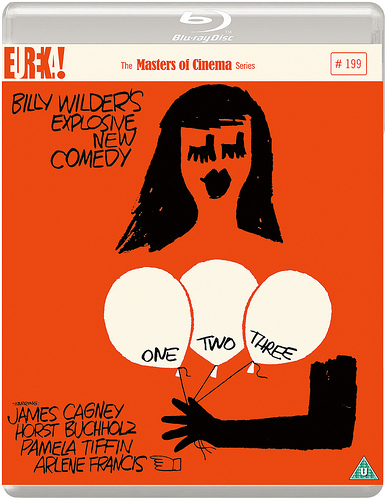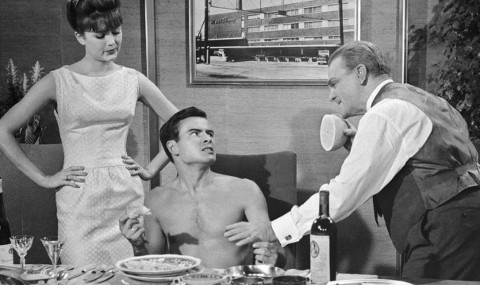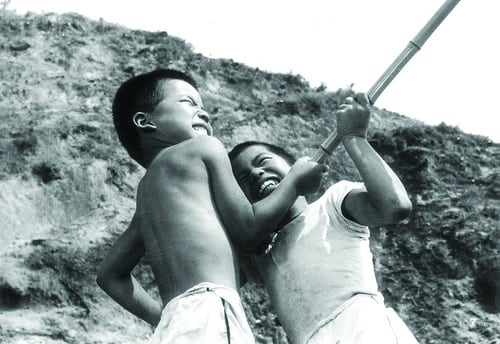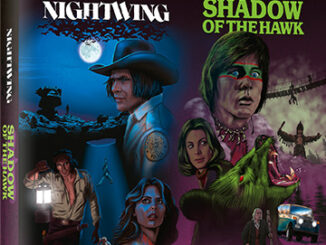One Two Three (1961)
Directed by: Billy Wilder
Written by: Billy Wilder, I.A.L. Diamond
Starring: Arlene Francis, Horst Buchholz, James Cagney, Pamela Tiffin
USA
AVAILABLE ON BLU-RAY: NOW, from EUREKA ENTERTAINMENT
RUNNING TIME: 108 mins
REVIEWED BY: Dr Lenera, Official HCF Critic
C.R. “Mac” MacNamara is a high-ranking executive in the Coca-Cola Company, assigned to West Berlin after a business fiasco a few years earlier in the Middle East. What he really wants is to become head of Western European Coca-Cola Operations, based in London, though his wife, Phyllis, wants him instead to get a steady and stable job back at head office in Atlanta. While he’s working on a trade agreement of getting Coca-Cola into the Russian market, his boss, W.P. Hazeltine, assigns him the unveniable task of looking after his hot-blooded but dim 17-year-old socialite daughter, Scarlett. She secretly goes on trips to East Berlin and, when found out, announces that she’s married – to an East German beatnik named Otto Ludwig Piffl who despises Capitalism.…
Was it entirely down to the switching of screenwriters, from Charles Brackett to I. A. L. Diamond, that Billy Wilder’s films changed so much around the late ‘50s, narrowing focus from a wide variety of subjects to increasingly caustic, cold comedies, and that he therefore in the opinion of many went downhill after the high points of Some Like It Hot and The Apartment [the latter tying with Double Indemnity and Sunset Boulevard as his most perfect picture]? If it was, then how do you explain the brief artistic [though not commercial] revival in the 70’s with Avanti, The Private Life Of Sherlock Homes and Fedora, none of which seem entirely achieved [though the middle one of those films had around an hour lopped off it against his wishes], but are nonetheless offerings which seem to come from a different place, dispensing with the belly laughs and even, in the case of the first two, the bitterness? In any case, there are a few of the films in the longer second half of his career that I still haven’t seen, and one of these is One, Two, Three, which Wilder actually made after The Apartment. Would this be an unsung classic worthy of the two that preceded it, or would it already reveal a decline? Partly based on 1939’s Ninotchka which Wilder had co-written but unusually political for Wilder, it’s a hectic, some might say, exhausting picture, where, rather than build up to the big laughs, Wilder and Diamond decided to cram in as many jokes as they could think of, most of them mocking both Soviet Communism and American Capitalism. Many of their barbs are indeed funny, but after a while become repetitious as they just go over the same ground over and over again, and their stereotypical nature means that this film does seem to date more than many of Wilder’s others. But it may also be James Cagney’s greatest hour, and, yes, I’m including White Heat, and one of the other things this film does is seem to play on some of his previous roles, indeed his whole image.
Wilder once claimed that he used nothing of the Ferenc Molnar play that inspired this film except for one line of dialogue. He decided to shoot it in Berlin, which was the main reason that Cagney took the lead role, who grew up in an area of Manhattan that was full of German immigrants. However, it wasn’t the most pleasant filming experience for him. He openly hated co-star Horst Buchholz because he kept trying to steal scenes, while Wilder’s penchant for retakes and the tiring nature of a part which required him to continually bark out reams of dialogue at top speed were instrumental in causing him to retire from acting until a brief comeback in Ragtime twenty years later. During filming, Wilder received a call from Joan Crawford, recently appointed to the board of directors of Pepsi-Cola following her husband Alfred Steele’s death. Crawford protested over the use of the Coca-Cola brand in the film, causing Wilder to add a few references to Pepsi, most notably the final scene. The building of the Berlin Wall began on the night of August 13, 1961, right through a set that had been built at the Brandenburger Tor. Production had to move to Munich to shoot the missing scenes on the car park of the Bavaria Film Studios, where a copy of the lower half of the bridge had to be built,and the Goldwyn Studios in Hollywood. The Saul Bass-designed poster that Wilder originally intended for the film’s release featured a United States flag sticking out of a Coca-Cola-style bottle, but it had to be replaced when Coca-Cola threatened legal action against United Artists for copyright infringement. The film’s setting seemed to turn audiences off, while critical reception was mixed.
The introduction to the four main stars, posing for the camera in their roles, is unusual for the period, but was common in the early ’30s when Cagney, of course, broke into stardom. The titles are followed by some tongue in cheek scene setting by Cagney’s character which also basically introduces the two man targets of the film. It’s American versus Eastern-bloc: baseball, soft drinks, greed, waste, the Pledge of Allegiance, even Gone With The Wind – versus the party, propaganda, missiles, caviar, trains that don’t run on time and endless parading. Americans are arrogant, ignorant, sex-mad and success-driven, while the East Germans and Russians are sneaky, rigid, paranoid Marx-spouters. It’s about evenly balanced, with perhaps a few more attacks on the East but a few more of the main characters being American, so it’s really is about even really. And Mac is really one of the least sympathetic of Wilder’s ‘heroes’. He blatantly carries on with secretary after secretary despite having a wife and two kids whom he drags all over the world as he goes from place to place, always after making money. He’s currently trying to get the Russians to accept Coca-Cola, and knows that they’ve been after the secret recipe for ages. They tried to make their own version but it failed miserably [“Even the Albanians won’t drink it, they use it for sheep dip”], while two spies sent over to steal the formula ended up defecting. In his Berlin office, workers stand to attention or click their heels because they’re used to doing it for the Fuhrer or were trained in the Gestapo. Funny? Well some of it was to me, but even if you admire the way certain gags, lines or even words are threaded throughout the screenplay like musical themes, it does feel like you’re having the same two points being rammed down your throat.
I would imagine if the film was released today, the Twitter mob would whinge about the Scarlett character being sexist or some other crap, but at least we can still enjoy ditzy blondes [okay, Scarlett isn’t blonde, but you’ll know what I mean] in older movies. She has some of the best lines. She’s in this troubled city because: “Everyone says it’s the hottest spot in town”. “He doesn’t wear shorts”, “No wonder they’re winning the cold war”. “He’s not a Communist, he’s a Republican. He comes from the Republic of Germany”. The guy she’s referring to is Otto, whom the man-hungry lass really falls for, marries and gets pregnant by. But Mac won’t have this and formulates a plot to get rid of him. There’s a car chase with a funny conclusion, a climactic airport dash much like Wilder’s earlier Sabrina, and even a little bit of cross dressing. But then this film has even more references to other films than Some Like It Hot, some of them from Cagney’s back catalogue. Nikita Khrushchev’s famous banging of his shoe on the podium during a speech at the United Nations is referenced when a Russian bangs a shoe on a table in a bar, causing the obligatory photograph of Khrushchev to fall out of its frame, revealing the picture of Josef Stalin, his predecessor, behind it. One joke spoken by an apparatchik even seems to foreshadow the Cuban Missile Crisis: “We have trade agreement with Cuba: they send us cigars, we send them rockets. “When retorts that they are “pretty crummy cigars,” the Russian replies that they send the Cubans “pretty crummy rockets.”
But too much of the film consists of Mac and Otto sniping at each other, and lines like: “He could use a haircut, and I’d like to give it to him and a hammer and sickle”. Yes, it’s a funny line, but it’s soon followed by thirty successive jokes broadly doing the same thing. But on the other hand the tension on set between the two main stars does sort of help. You can see that Buchholz is constantly trying to upstage Cagney, though instead of all his mugging he’d perhaps have been better off going for a more subtle performance. But Cagney, a whirling dervish at the heart of a storm he can’t control, and often little different from his iconic gangster roles [yes, he even threatens somebody with a grapefruit] is just on fire throughout, and especially in the terrific final quarter where for much of the time we really are watching an elaborate stage farce as Mac has trouble juggling everything while trying to give Otto a makeover [don’t ask]. It’s tiring to watch, but you still don’t want it to stop, and you do wish him to pull everything off, yet the script is strong enough to also make his wife Phyllis into a sympathetic person instead of the nagging shrew you might expect, and yet also make you like Ingeborg his current secretary with “fringe benefits”, the character starting off as being very cliched but soon revealing layers. In fact the film even does well by its Russian and German characters, and I wouldn’t be surprised if interrogators over there really are using ‘The Itsy Bitsy Teeny Weenie Yellow Polka Dot Bikini song as a torture device. It’ll get me to talk, that’s me for sure.
There’s enough outdoor stuff to remind us of the stark setting without it intruding on the silliness,and there’s some nice deep focus cinematography from Daniel L. Fapp. Andre Previn wrote what little score there is, with Aram Aram Khachaturyan’s ‘Sabre Dance’ being the main theme. Its madcap energy is kind of appropriate, but I tend not to be a fan of classical music in movies as for me it sticks out too much. Others not familiar with the piece may feel differently. While I do feel that it could have diversified its humour somewhat [okay, there are a few borderline Carry On bits of smut], One, Two, Three still had me chuckling for some of the time which is more than I can say for a lot of recent comedies I’ve regretted going to see at the cinema, and I did grow to like all the principal people in it and even wanted to spend more time with them. It’s certainly not prime Wilder, in fact I’d say that it was slightly below average Wilder – but even that’s better than many others at their best.
Rating: 









Eureka bring One, Two, Three to Region ‘B’ Blu-ray in a solid restoration with plenty of depth and detail, though there’s a tiny bit of blurriness here and there on actor’s close-ups. They’ve ported over the audio commentary from the Region ‘A’ Kino Lorber release and replaced two snippets from Wilder interviews with Eureka stalwart Neil Sinyard talking about the film. The commentary track features Michael Schlesinger, whom I haven’t heard on these things before. Though he gives himself some breaks during Cagney’s best sequence, he still delivers a very packed, informative yet accessible track. I wouldn’t agree with him that this is “Wilder’s masterpiece”, but then critics do seeem to be divided over this one. He’s very good at pointing out topical references, some of which I failed to get, and you learn some interesting stuff such as how the film had its origins in a Marx Brothers project. I came out appreciating the film a bit more so Job Done. Sinyard is his typical laid back but perceptive self, not going that much into production but very good on placing the film in Wilder’s career [he thinks it’s closest to Stalag 17, which didn’t occur to me while I watched it but seems quite obvious in hindsight. He also mentions how this movie and others deal with Wilder’s major theme of European/American clashing, from a person who, like so many creative people of the time, fled Nazi Germany as a Jew to the United States.
For me, Wilder and Diamond’s satire in One, Two, Three was too blunt and restrictive to totally work, but the film stills offers plenty of chuckles. Recommended.
SPECIAL FEATURES
*Limited Edition O Card slipcase [2000 copies ONLY]
*1080p presentation on Blu-ray
*LPCM audio (original mono presentation)
*Optional English SDH subtitles
*Brand New and Exclusive Interview with film scholar Neil Sinyard [28 mins]
*Feature Length Audio Commentary by Film Historian Michael Schlesinger
*A Collector’s booklet featuring new essays by film scholar Henry K. Miller, critic Adam Batty, and archival material








Be the first to comment